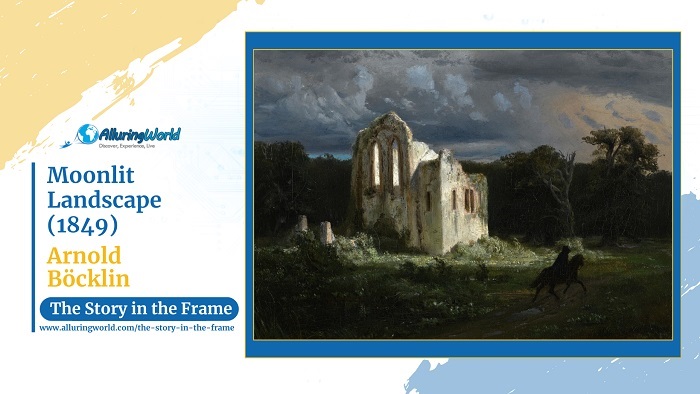Moonlit Landscape, officially referred to as Mondscheinlandschaft mit Ruine, is a dark painting that showcases an atmospheric depiction of the night, where nature is bathed in the ethereal glow of the moon, and it was painted by Arnold Böcklin in 1849. As the artist is known for his symbolist and romantic tendencies, he infuses this work with a sense of mystery and tranquility, so the painting portrays a secluded scene where the landscape is illuminated by the soft, silvery light of the moon, evoking a dreamlike quality that invites viewers into a quiet, introspective world.
About the Painter:
Arnold Böcklin (1827–1901) was a Swiss painter closely associated with Symbolism, though his early works were influenced by Romanticism. Fascinated by mythology, fantasy, and nature, Böcklin often created compositions that transcended realism to explore deeper emotional and philosophical themes, and his works frequently included eerie atmospheres, fantastical creatures, and dramatic lighting, reflecting his interest in the supernatural and the power of imagination. Though he is best known for Isle of the Dead, his landscapes also showcase his skill in capturing mood and mystery through masterful use of light and color.
Inspiration and Reasons Behind the Painting:
Moonlit Landscape reflects Böcklin’s fascination with nature as a source of mystery and contemplation, and as the 19th century saw a rise in Romanticism, which emphasized emotional depth and the sublime in natural settings, Böcklin was deeply inspired by German and Swiss landscapes, as he often painted them in ways that suggested hidden meanings. The moonlight in this piece may refer to solitude, reflection, or even an otherworldly presence, inviting viewers to interpret its quiet beauty in a personal way.
What is Depicted in the Painting:
The painting showcases what seems like a secluded forest, meadow, or body of water under the illumination of a full moon where tall trees are casting long, ghostly shadows, while the sky is filled with a deep, velvety darkness, interrupted only by the glow of the moon and stars. The center of the painting shows a ruin, possibly a former residence of a noble family that is lit by the strong presence of the moon. As there may be figures, animals, or structures subtly hidden within the scene, blending into the mysterious night time atmosphere, in the lower right section can be seen a very mysterious horse rider all dressed in black attire, riding in the night towards the moonlit path. The overall composition suggests a moment frozen in time, where nature remains still and contemplative under the moon’s watchful gaze.
Colors and Techniques:
Böcklin’s use of color in Moonlit Landscape is likely dominated by deep blues, grays, and muted greens, creating a rich nocturnal atmosphere. The moonlight serves as the primary source of illumination, casting silvery highlights on trees, water, and distant hills. Böcklin’s brushwork, often fluid yet precise, enhances the textural details of foliage, water ripples, or rocky formations. His ability to blend colors seamlessly allows for an atmospheric depth that draws viewers into the scene, making them feel as though they are standing in the quiet stillness of the moonlit night.
Conclusion:
Overall, Moonlit Landscape is a striking example of Arnold Böcklin’s ability to merge Romantic and Symbolist influences into a single, evocative composition. The painting’s haunting beauty and serene mood capture the timeless allure of the night, emphasizing the power of nature to inspire introspection. Even today, Böcklin’s landscapes remain compelling, inviting viewers to step into a world where light and shadow blend into an atmosphere of quiet mystery and poetic elegance.

